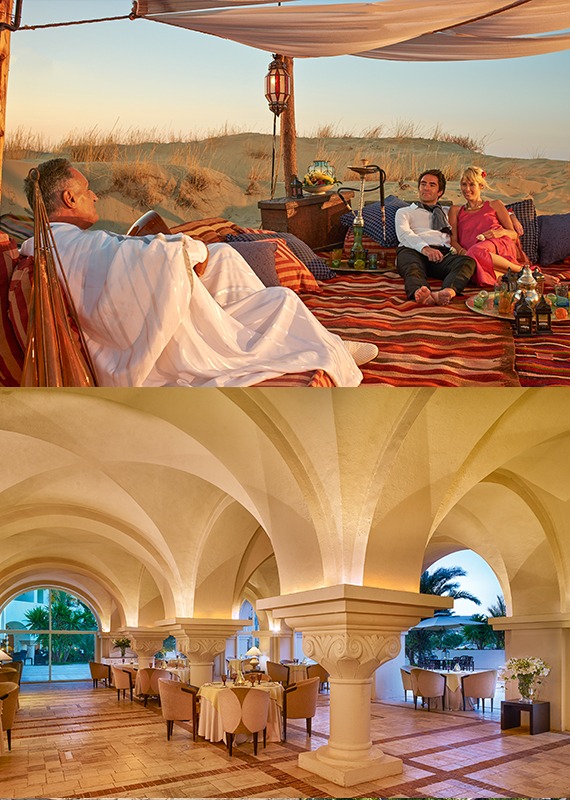During a brilliant long weekend in Tunis I learned how to cook delicious local food, immersed myself in the culture – and found out what links King of Pop Michael Jackson, painter Paul Klee and fashion designer Azzedine Alaïa.
My base was the recently refurbished, five-star The Residence, Tunis. Beautifully designed throughout – a mash-up of colourful, traditional Tunisian and modern contemporary styles, from its huge Moorish reception complete with palm trees, to the comfortable, light and airy accommodation – it’s just 40 minutes from the airport and 25 minutes to Carthage, the site of our first cultural excursion with local guide and expert on all things Tunis, Fethi Bouguezzi.

Arriving at the UNESCO World Heritage site Fethi asked us, “How many Carthages do you think there are in the world? Sixty five! Of course, Cartagena is the same name, which means ‘New Town’, but ours is the oldest!”
Carthage survived various attacks and two Punic wars and was declared a UNESCO World Heritage Site in 1972 – sadly not before as much as 60 per cent of the internationally important archaeology was lost under modern houses. But there are still plenty of ruins to explore, including the remains of centuries old houses and burial sites. It was while looking at the tomb of an unknown teenager that Fethi told us the story of Hannibal and how, rather than surrender to the Romans, he drank poison, after which his body was whisked off to Turkey, where it remains today (its precise location unknown.)
Close to the main site are the imposing Antonine baths. “They were the third largest public baths in the Roman Empire, and stood as high as a seven-story building.” A rebuilt column gives you an idea of the scale of the buildings. Hungry from so much history, we returned to the hotel for an immersive cooking class. Our lunch was shakshouka (the spicy onion, pepper, tomato and egg stew that’s currently giving smashed avo a run for its money on brunch menus), mechouia salad (chargrilled peppers and aubergine mashed up with garlic and coriander) and samosa-like brik, filled with potato, capers, tuna and egg. But before we cooked, we foraged ingredients in the hotel’s Earth Basket, a sustainable herb and vegetable garden that’s also home to geese and cute rabbits that are definitely not for eating (I asked.) Children are welcome in the garden too: the Residence’s kids’ club provides activities that include learning about planting and growing food, along with swimming and camel rides on the hotel’s private stretch of beach.
 With its vaulted ceiling and ornate columns, L’Olivier, the hotel’s Mediterranean restaurant makes quite an impression
With its vaulted ceiling and ornate columns, L’Olivier, the hotel’s Mediterranean restaurant makes quite an impression
Like everyone we met in Tunis, our chefs Akram and Ahmed were super friendly and enthusiastically answered our questions about Tunisian culture and its cuisine, something the hotel is keen to promote. Jamie Oliver filmed here recently, cooking local dishes on the beach, and the hotel was delighted that one of its team was featured.
Traditional food and drink are also showcased at El Dar restaurant. Dar is Arabic for Home, and the restaurant is decorated in the traditional red and green stripes of Tunisia. A local musician gently played a lute while we feasted on octopus salad and grouper with cous cous. The highlight of the meal came when our waiter knocked the top off a clay pot with a huge sword, revealing the slow baked lamb inside.
Other dining options at the hotel include L’Olivier, which focuses on Mediterranean flavours, and Li Bai, the first Chinese restaurant in Tunis.
Breakfast deserves an honourable mention at this point. Buffet-style it offers huge Continental spreads as well as local pastries, soups and delicacies including mtagbas, hand rolled pastries baked to order and that can be slathered with Nutella or filled with spicy shakshouka. There are also excellent syrupy fresh strawberry and tooth-jangly lemon juices, local teas and coffees.
The pandemic, of course, was terrible for the hotel business (particularly given that Tunisia was still trying to rebuild its tourism after the 2015 terrorist attacks) but the team at The Residence, which opened in 1996, used the downtime to freshen up the rooms. The hotel has 161 rooms and nine suites, the most luxurious of which is suite 336, which has welcomed Hugh Grant, Hilary Clinton and Nelson Mandela, among others.
During the pandemic they also rebuilt the glorious outdoor pool, which also has a poolside bar and restaurant. A second pool can be found inside the hotel’s Thalasso spa – another first for Tunis. The pool and its Jacuzzi are filled with saltwater heated to 32 degrees and are the ideal spot for relaxing ahead of a treatment – a seaweed, mud or oil wrap perhaps, or an authentic Hammam body exfoliation. Plenty of massages and hydrotherapy treatments are on the menu too, along with Clarins facials.

The hotel also has its own 18-hole golf course that’s gloriously green all year round thanks to an ingenious (and top-secret) irrigation system, so you can play here when the UK and Europe are less inviting. A golf school offers tuition for all levels.
Our second trip out with Fethi was to the newly reopened Bardo National Museum, housed within a beautiful palace with incredible domed ceilings and amazing stucco work, and home to a peerless collection of mosaics. From here we made our way to the buzzy Medina (old town). Once a walled city protected by 18 gates, of which five remain, the Medina is home to some 200 palaces and 40 souks selling rugs (so many rugs!), metalwork and traditional local chechia, a kind of red beret. There’s a gold market too: in the grounds of the Bardo museum. Fethi grabbed a pod from a tree, cracking it open to reveal a dark brown seed and pronouncing: “This is carob! They used to use the seeds to weigh gold – that’s where we get the word carat.”
Finally, we were taken to Sidi Bou Said, a pretty seaside town painted white and blue, with cobbled streets and bougainvillea spilling over walls. There is a little souk, too, where, as with inside the Medina, Fethi seems to know everyone. Sitting down for coffee our guide told us about the time Michael Jackson popped into the café when he was playing at the local stadium, drawing crowds the likes of which had never been seen before. Later on, we passed the home of the late fashion designer and Tunis native Azzedine Alaïa, now a foundation celebrating his body con creations, and a sign about the 1914 visit of painter Paul Klee who spent time in the town as part of a working holiday that would inspire him for many years afterwards. It is not hard to see why.

THE RESIDENCE SWIMMING POOL

